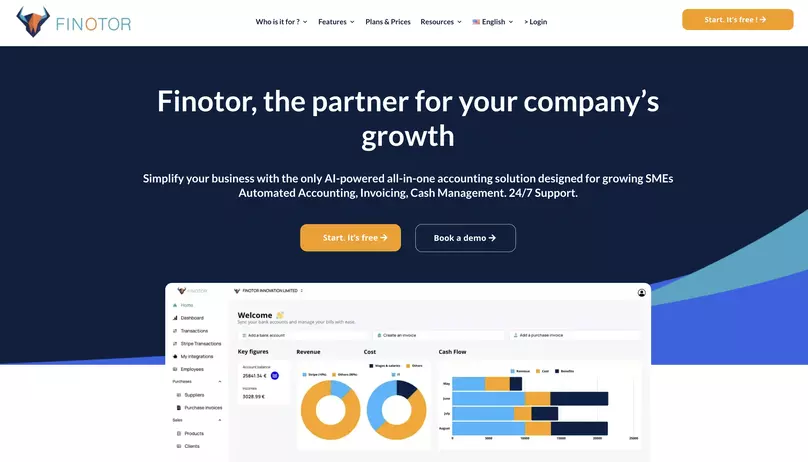Contents
Understanding the Basics of Profit in Business
Defining Operating Profit: The Core of Business Functionality
When discussing the fundamentals of business finance, the term operating profit comes to the forefront. Operating profit, often referred to as operating income, represents the profit a company makes from its core business functions before subtracting interest and taxes. It is a key metric that reflects a company’s operational efficiency and its ability to generate profit from its primary business activities. Calculating operating profit involves subtracting operating expenses, such as wages, depreciation, and cost of goods sold (COGS), from the company’s total revenue. For firms like Finotor, which offers comprehensive finance and account management solutions, understanding operating profit is critical, as it indicates the success of their integrated systems in driving business growth.
Gross Profit Explained: The First Indicator of Financial Health
Gross profit serves as an initial gauge of a company’s financial well-being. It’s calculated by deducting the cost of goods sold from total revenue. Gross profit provides insights into a company’s production efficiency and profitability at the most basic level of trading. By analyzing gross profit, businesses can assess whether their production costs are in alignment with industry standards. For companies utilizing platforms like Finotor, which streamline financial processes, monitoring gross profit can be seamlessly integrated into their financial analysis, ensuring that they stay competitive and profitable.
Importance of Profit Metrics for Stakeholders
Profit metrics such as operating and gross profit are not just internal indicators of a company’s performance; they are also critical for stakeholders who have vested interests in the business. Investors, creditors, and shareholders rely heavily on these figures to make informed decisions related to investments, lending, and management effectiveness. Tools that aid in the precise calculation and real-time analysis of these metrics, like the services provided by Finotor, are invaluable in today’s data-driven business environments. By understanding the nuances of profit metrics, stakeholders can better gauge the company’s financial health and strategic direction.
For those seeking a deeper understanding of the differences between gross and operating profit, and their implications for business strategy, resources such as Investopedia and Indeed offer detailed explanations and expert insights into these important financial concepts.
Breaking Down Gross Profit
Understanding the nuances of gross profit is essential for any business owner or financial manager. It’s a critical indicator of the efficiency of your core operations and sets the stage for all remaining financial analysis.
Calculating Gross Profit: Revenue Minus Cost of Goods Sold
The formula for calculating gross profit is straightforward: Gross Profit = Revenue – Cost of Goods Sold (COGS). This figure represents the direct profit from your sales after deducting the cost of producing or purchasing the goods sold. It’s the first glimpse into the financial health of a company, showing how effectively it can produce and sell products for a profit.
Role of Gross Profit in Pricing Strategies
Gross profit plays a pivotal role in determining the pricing strategies of a company. By analyzing gross profit, businesses can adjust their pricing models to ensure they cover costs and generate enough margin to invest in future growth. It’s a fine balance between being competitive and maintaining profitability, which is where tools like Finotor can be invaluable in providing data-driven insights for decision-making.
Gross Profit Margin: A Tool for Competitive Analysis
The gross profit margin, calculated by dividing gross profit by revenue, serves as a tool for competitive analysis. This percentage provides a quick glance at how each dollar of revenue is being utilized in terms of production costs. A high gross profit margin indicates a competitive edge in cost control, whereas a lower margin might signal the need for efficiency improvements or pricing adjustments. Comparing gross profit margins across industry peers can shed light on a company’s performance in the marketplace.
Delving into Operating Profit
While gross profit focuses on the core aspects of production and sales, operating profit provides a wider lens, encompassing the day-to-day operational expenses of running a business.
Operating Profit Calculation: Beyond COGS to Operating Expenses
Operating profit takes the analysis a step further by subtracting operating expenses—such as salaries, rent, and utilities—from the gross profit. This figure represents the profit generated from a company’s core business operations before interest and taxes are taken into account. It’s a more comprehensive look at the company’s operational efficiency and financial health.
The Impact of Operating Efficiency on Profitability
Enhancing operating efficiency can have a significant impact on a company’s profitability. Streamlining processes, adopting new technologies like AI and machine learning through solutions offered by Finotor, and reducing overhead can dramatically improve operating profit. Businesses striving for profitability need to constantly analyze and optimize their operational expenses.
Operating Margin as a Measure of Company’s Health
Operating margin, the ratio of operating profit to revenue, is an indicator of the company’s overall health. It shows how much profit is made from regular business operations, providing insights into the business’s sustainability and long-term viability. A consistent operating margin suggests a stable business model, while fluctuations can highlight areas in need of strategic adjustments.
Comparing Operating Profit and Gross Profit
Gross profit and operating profit are both critical metrics, but they serve different functions in financial analysis and strategic decision-making.
Key Distinctions in Profitability Analysis
The key distinctions between gross and operating profit lie in what costs are considered. Gross profit measures the efficiency of production and initial profitability, while operating profit accounts for the broader operational costs and is a truer reflection of a company’s profitability.
How Operating Profit Reflects the Real Costs of Business Operations
Operating profit reflects the real costs of business operations, including the administrative and selling expenses that are necessary to run the company. It’s a more stringent measure of profitability, as it takes into account the overhead that gross profit does not consider.
Using Gross and Operating Profits to Inform Strategic Decisions
Understanding both gross and operating profits is essential for making informed strategic business decisions. While gross profit offers a snapshot of production efficiency, operating profit provides insight into the effectiveness of the overall operational management. Businesses must analyze both to ensure long-term growth and sustainability, leveraging tools like Finotor for comprehensive financial management.
Comparing Operating Profit and Gross Profit
Understanding the nuances between operating profit and gross profit is essential for any business focused on financial acuity. While both metrics offer valuable insights into a company’s financial state, they each serve different purposes and can tell a different story about the health and performance of a business. In this section, we’ll explore the distinctions between these two profit types and how businesses can leverage them for strategic advantage.
Key Distinctions in Profitability Analysis
When analyzing profitability, understanding the key differences between operating profit and gross profit is crucial. Gross profit is the income a company makes after deducting the costs associated with making and selling its products, or the costs of goods sold (COGS). However, it doesn’t take into account other operating expenses such as marketing, research and development, and general administrative costs.
In contrast, operating profit is the profit a business earns after subtracting the operating expenses from the gross profit. It provides a more comprehensive view of a company’s financial performance by considering both the cost of goods sold and the costs required to run the company on a day-to-day basis. This measure is often used to assess a company’s operational efficiency and its ability to generate profit from its core business activities.
How Operating Profit Reflects the Real Costs of Business Operations
Operating profit is a closer reflection of the real costs associated with running a business. It includes not only the direct costs of producing goods but also the indirect costs required for overall operations. These expenses include rent, utilities, payroll for non-production staff, and other overhead costs. By considering these additional expenses, operating profit offers a clearer picture of the company’s profitability and cash flow potential.
Improving operating profit often requires a business to enhance its operational efficiency. This may involve optimizing supply chain management, reducing waste, or investing in technologies that streamline operations. For businesses like Finotor, which provide comprehensive financial management solutions, tools that offer detailed insights into operating costs can be invaluable for businesses seeking to improve their operating margins.
Using Gross and Operating Profits to Inform Strategic Decisions
Both gross and operating profits serve as important indicators for strategic decision-making. Gross profit can inform businesses about the profitability of their products and services and can be used to set competitive pricing strategies. It’s a measure that’s directly influenced by production efficiency and cost control in the procurement of goods.
Conversely, operating profit provides insight into the effectiveness of a company’s management in controlling broader operational costs. It’s indicative of the business’s ability to sustain operations and expand. Companies that monitor their operating profit closely can identify opportunities for reducing expenses and reallocating resources towards more profitable ventures.
In conclusion, while gross profit focuses on the essential production costs, operating profit encompasses a wider range of expenses, offering a more in-depth view of a company’s financial health. A deep understanding of both can guide businesses in fine-tuning their operations and strategies for long-term success. For businesses seeking a robust financial management system that can aid in this analysis, Finotor’s all-in-one solution can provide the necessary tools for detailed financial oversight and strategic decision-making.
Comparing Operating Profit and Gross Profit
Key Distinctions in Profitability Analysis
Understanding the difference between operating profit and gross profit is crucial for any business aiming to fine-tune its financial strategy. Gross profit, calculated as sales revenue minus the cost of goods sold (COGS), serves as the preliminary indicator of a company’s profitability. It reflects the efficiency of production and the raw profitability of goods or services sold, without accounting for the broader operational costs.
On the other hand, operating profit, or operating income, takes the analysis a step further by subtracting operating expenses from the gross profit. This includes costs such as salaries, rent, utilities, and other overheads. Operating profit demonstrates the profitability of the company’s core business activities, giving stakeholders a clearer picture of operational efficiency and the company’s ability to generate profit from its primary business functions.
How Operating Profit Reflects the Real Costs of Business Operations
While gross profit provides a surface-level view of financial health, operating profit delves deeper into the reality of the business operations. It accounts for all the costs associated with running the day-to-day business, beyond the simple cost of producing goods or delivering services. This encompasses everything from administrative and general expenses to research and development, and marketing costs.
Operating profit is often seen as a more accurate reflection of a company’s financial performance because it includes the impact of management decisions and operational control. For a company like Finotor, with its focus on streamlining business operations through AI and machine learning, emphasizing the importance of operating profit is part of demonstrating the value of its services. By potentially reducing operational expenses with better management tools, Finotor can help improve a company’s operating profit.
Using Gross and Operating Profits to Inform Strategic Decisions
Both gross and operating profit metrics are invaluable for informing strategic business decisions. Gross profit can influence pricing strategies, product line decisions, and can point to the need for cost-cutting measures in production. It’s a measure that can help businesses like those using Finotor’s financial management solutions to identify inefficiencies at a product or service level.
Operating profit, however, is more encompassing, providing insight into the effectiveness of the management team and the overall operational strategy. It can guide decisions on whether to increase investment in certain areas or to cut back on expenses. Furthermore, operating profit is instrumental in operational benchmarking, where companies can compare their performance against competitors. For example, tools that integrate with systems like Stripe and WooCommerce, as offered by Finotor, can simplify financial operations and potentially enhance operating profit margins.
In-depth analyses of these profits, including gross vs. operating profits, help businesses understand not just the cost of selling, but the cost of operating as a whole. This dual-perspective is essential for holistic financial planning and for maintaining a competitive edge in today’s market.
By leveraging insights from both gross and operating profit figures, businesses can fine-tune their operations, identify cost-saving opportunities and invest in growth areas. Finotor’s comprehensive financial management platform is designed to aid in these strategic decisions, providing real-time data and analytics that enable businesses to optimize their financial performance.









